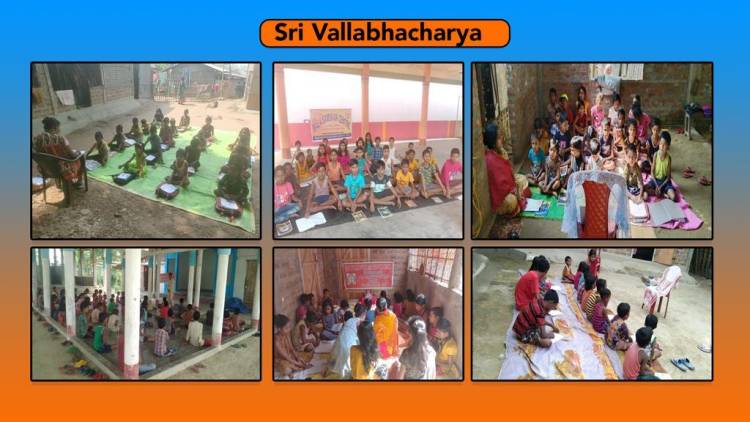[GHHF] Bala Samskar Kendras in Assam – Students learned about Vallabha Acharya, his life and Philosophy
 Alexander Zinoviev
Alexander Zinoviev
"So, what must be done in order to save Hinduism and stop the Islamic flood? There is only one way and it is called mass conversion of Muslims into Hinduism. If Hindus want to survive, they must convert. They must adopt the strategy of Catholic missionaries and Muslim mullahs. I don’t mean only conversion of one-time Hindus that only recently adopted other religions …. Hinduism must convert also people of non-Hindu origin. The fact that they live in India is enough because all Indians, notwithstanding their religious affiliation, had once had Hindu ancestors."
Global Hindu Heritage Foundation is very happy to inform you that we have started Bala Samskar Kendras (Schools for children and youth) to enrich them with the greatness of Hindu Dharma and appreciate the sacrifices many leaders have done to protect Bharat. There are many kings who have achieved new heights in their skills, talents, and strength. Unfortunately, Bharath denies its history to its own children and glorified the most undeserving rulers. The government has corrupted the minds of young students since Independence from 1947. It is our effort to teach them the greatness of our scriptures, enrich their minds with timeless wisdom, create a sense of pride through time-tested moral and ethical compass, and make them proud of the science behind all our customs and traditions.
Bala Samskar Kendras started in 2021 and now we have about 200 Bala Samskar Kendras in five States in India and four in Bangladesh. They are very active and large number of children are attending and many parents are impressed with their own children and how much they are learning and how they changed behaviorally. Students were taught to chant Hanuman Chalisa.
Sri Vallabha Acharya
Today students learned about Vallabhacharya Mahaprabhu (1479–1531 CE), also known as Vallabha, Mahaprabhuji and Vishnuswami, or Vallabha Acharya, is a Hindu Indian saint and philosopher who founded the Krishna-centered PushtiMarg sect of Vaishnavism in the Braj(Vraj) region of India,[1] and the Vedanta philosophy of Shuddha Advaita (Pure Non-dualism).
He is the Jagadguru Acharya and Guru of the Pushti Marg bhakti tradition and Suddhadwait Brahmavad (Vedant Philosophy), which he founded after his own interpretation of the Vedanta philosophy.[1][6][7]
Vallabhacharya was born in a Telugu Tailang Brahmin family that had been currently residing in Varanasi, who escaped to Champaran of Chhattisgarh state while expecting shri Vallabha, expecting a Muslim invasion in Varanasi, during the late 15th century.[8] The name Vallabha means the beloved or lover, and is a name of Vishnu and Krishna.
Vallabhacharya studied the Vedas, Upanishads, Puranas, Shat Darshan as a child, then travelled throughout the Indian subcontinent over 20 years.[8] He became one of the important leaders of the devotional Bhakti movement. Vallabhacharya's mother was Illamma who was the daughter of a family priest serving the rulers of the empire of Vijayanagara.[9] The biographies written by his followers, just like those for other Bhakti leaders, claim that he won many philosophical scholarly debates against the followers of Adi Shankaracharya, Ramanuja, Madhvacharya and others, had visions and miracles.
Vallabha's writings and kirtan compositions focus on baby Krishna and his childhood pranks with Yashoda (unconditional motherly love), as well as a youthful Krishna's protection of the good (divine grace) and his victory over demons and evils, all with allegory and symbolism.
One of the Milestones in his Life
At the age of 11-12, when he went for the Darshan of Sri Jagannatharaiji, he was informed about the prevailing debate on philosophical scriptures in the court of the king. He also came to know that the opponents have dominated the Vaishnava scholars. He immediately rushed to the court, took the charge of the debate, and defeated all the opponents.
In this very assembly the king placed four questions to be answered by the Pundits and Acharyas. The questions were:
• Which Scripture is the best of all scriptures
• Which deity is the best of all deities?
• Which Mantra is the best of all Mantras?
• Which duty is the best of all duties?
Many learned Pundits and Acharyas gave different answers to these four questions but the assembly could not reach on any common conclusion. At last, at the hint of Shri Vallabhacharya, all four questions were unanimously placed before Lord Shri Jagannatha (Sri Krshna). Along with this, a blank paper, an inkpot and a pen were placed in front of Lord Jagannatha. The doors of the temple were closed. When the doors were opened, the piece of paper with a verse answering all the four questions written on it was found. The verse was:
“Ekam shashtram devaki putra gitam
Eko devo devakiputra eva;
Mantropyekas tasya namani yani,
Karmopyekam tasya devasy seva.”
Meaning:
Gita sung by Shri Krshna, son of Devaki, is the best scripture.
Shri Krshna, son of Devaki, is the best deity.
Names of Sri Krshna are the best Mantra.
Service of Sri Krshna is the best duty.
Sri Gopinathaji, elder son of Sri Vallabhacharya has described this incidence in an authorizing letter dated 30 of Vaishakha month of V.S.1595 in Sanskrit to his Tirtha Purohit (An authorized Brahmin that performs ritual at sacred places of pilgrimages on arrival of concerned pilgrims) of Shri Jagannathpuri.
DONATIONS
PayPal Method: To donate visit our website: savetemples.org. Click on the Donate button, then press the Purpose category, and select the General Donation category.
By Check: Or you can send a check payable to: GHHF, It is tax-deductible.
By Zelle: ghhfusaorg@gmail.com
By Rupees, please contact us by either phone or email.
For more information, call Prakasarao V Velagapudi 601-918-7111 ; Email: ghhfusaorg@gmail.com














 Urgent support needed for Bangladesh Hindus
Urgent support needed for Bangladesh Hindus 







